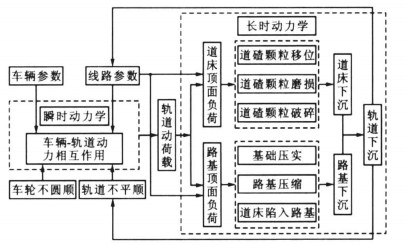Analysis of parameters' effects on settlement of ballasted track
-
摘要: 为理解轨道下沉变形产生与发展机理及主要影响参数, 以道床下沉为例, 运用车辆-轨道耦合动力学理论和轨道下沉变形法则, 借助已开发的仿真分析程序, 分析了运营条件与轨道结构参数对道床下沉变形的影响。分析结果表明: 车辆运行速度、车辆轴载、线路运量是轨道下沉破坏主要控制因素; 采用重型钢轨、大截面尺寸轨枕和重质道碴可以降低道床下沉量; 轨枕间距大, 道床弹性模量高, 不利于道床下沉变形的控制; 当路基K30模量小于90 MPa·m-1时, 道床下沉量随着K30值的增加而增大, 当K30值大于90 MPa·m-1时, 随着K30值的增加道床下沉量反而降低。可见, 为了阻止有碴轨道下沉变形, 应注重轨道结构参数的匹配, 合理安排运输。Abstract: In order to comprehend the occurring and growing mechanism of track settlement, ballast bed settlement was regarded as study object, and the effects of transportation conditions and track structure parameters on ballast settlement were analyzed by using simulation analysis program based on vehicle-track coupling dynamics and track settlement laws. Analysis result shows that vehicle running speed, vehicle axle load and railway traffic are main control factors of track settlement; it benefits to decrease ballast settlement by adopting heavy rail, big size sleeper and high density ballast; big sleeper space and high ballast elastic modulus are disadvantageous to control ballast settlement; the effect of subgrade modulus K30 is complex, ballast settlement increases with the increase of K30 when K30 is less than 90 MPa·m-1, ballast settlement reduces with the increase of K30 when K30 is more than 90 MPa·m-1. Obviously, in order to decrease track settlement, it is important to match track structure parameters and arrange transportation reasonably.
-
表 1 不同钢轨类型条件下道床下沉量
Table 1. Ballast settle ments in the condition of different rail types

表 2 不同轨枕类型条件下道床下沉量
Table 2. Ballast settlements in the condition of different sleeper types

-
[1] 曾树谷. 铁路散粒体道床[M]. 北京: 中国铁道出版社, 1997. [2] Frederick C O. 轨道几何形态的恶化[J]. 中国铁道科学, 1982, 4(1): 113-124. https://www.cnki.com.cn/Article/CJFDTOTAL-ZGTK198201008.htmFrederick C O. Geometric track deterioration[J]. China Railway Science, 1982, 4(1): 113-124. (in Chinese) https://www.cnki.com.cn/Article/CJFDTOTAL-ZGTK198201008.htm [3] 曾树谷, 苏小楼, 栾承高. 道床物理、力学性能的试验研究[J]. 中国铁道科学, 1983, 5(1): 60-71. https://www.cnki.com.cn/Article/CJFDTOTAL-ZGTK198401004.htmZeng Shu-gu, Su Xiao-lou, Luan Cheng-gao. The basic physical and mechanical properties of ballast layer[J]. China Railway Science, 1983, 5(1): 60-71. (in Chinese) https://www.cnki.com.cn/Article/CJFDTOTAL-ZGTK198401004.htm [4] Shenton MJ. Ballast deformation and track deterioration[C]∥Karagiannis D. Track Technology. London: Lonson Thomas Telford, 1985: 11-13. [5] Lundqvist A, Dahlberg T. Dynamic train/track interaction including model for track settlement evolvement[J]. Vehicle System Dynamics, 2004, 41(Sup): 667-676. [6] Fr hling R D. Lowfrequency dynamic vehicle/trackinteraction modeling and simulation[C]∥Palkovics L. The Dynamics of Vehicles on Roads and on Tracks. Lisse: Swets & amp; amp; Zeitlinger, 1998: 30-46. [7] 石田誠, 名村明, 瀧川光伸, 等. 軌道沈下の実験とシミュレ?シヨンによる予測[J]. 鉄道総研報告, 2002, 16(4): 41-47. [8] 周宇, 许玉德, 李浩然. 轨道不平顺非线性预测模型[J]. 交通运输工程学报, 2004, 4(4): 21-24. doi: 10.3321/j.issn:1671-1637.2004.04.006Zhou Yu, Xu Yu-de, Li Hao-ran. Nonlinear trackirregularity forecast model[J]. Journal of Traffic and Transportation Engineering, 2004, 4(4): 21-24. (in Chinese) doi: 10.3321/j.issn:1671-1637.2004.04.006 [9] 陈宪麦, 王澜, 杨凤春, 等. 用于铁路轨道不平顺预测的综合因子法[J]. 中国铁道科学, 2006, 27(6): 27-31. doi: 10.3321/j.issn:1001-4632.2006.06.006Chen Xian-mai, Wang Lan, Yang Feng-chun, et al. Integrating factor method for predicting the developing trend of railway track irregularity[J]. China Railway Science, 2006, 27(6): 27-31. (in Chinese) doi: 10.3321/j.issn:1001-4632.2006.06.006 [10] 卢祖文. 铁路轨道结构及修理[M]. 北京: 中国铁道出版社, 2002. [11] 翟婉明. 车辆-轨道耦合动力学[M]. 北京: 中国铁道出版社, 2002. [12] Zhai Wan-ming, Wang Kai-yun, Lin Jian-hui. Modelling and experiment of rail way ballast vibrations[J]. Journal of Sound and Vibration, 2004, 207(4/5): 673-683. [13] 内田雅夫, 石川达也, 名村明, 等. 軌道狂い進みに着目した有道床軌道の新しい設計法[J]. 鉄道総研報告, 1995, 9(4): 37-42. [14] 王开云, 翟婉明, 刘建新, 等. 线路不平顺波长对提速列车横向舒适性的影响[J]. 交通运输工程学报, 2007, 7(1): 1-5. doi: 10.3321/j.issn:1671-1637.2007.01.001Wang Kai-yun, Zhai Wan-ming, Liu Jian-xin, et al. Effect of rail irregularity wave length on lateral running comfort of speed-raised train[J]. Journal of Traffic and Transportation Engineering, 2007, 7(1): 1-5. (in Chinese) doi: 10.3321/j.issn:1671-1637.2007.01.001 [15] 张雷. 弹性轨枕有碴轨道的基础试验与动力分析[D]. 成都: 西南交通大学, 2005. -





 下载:
下载:












